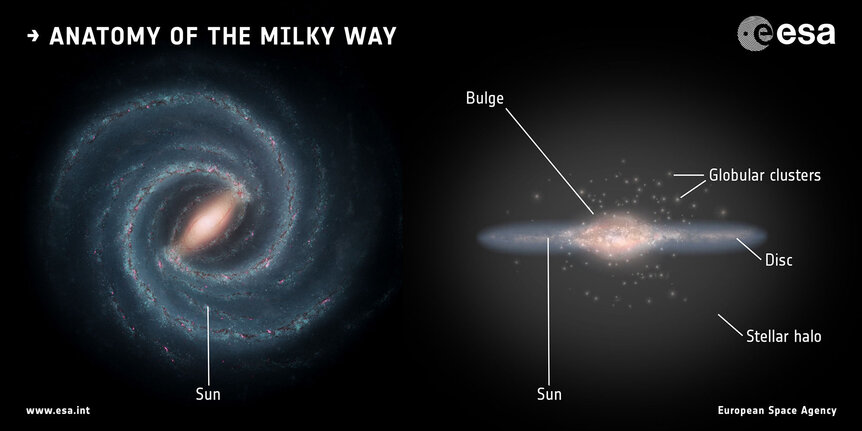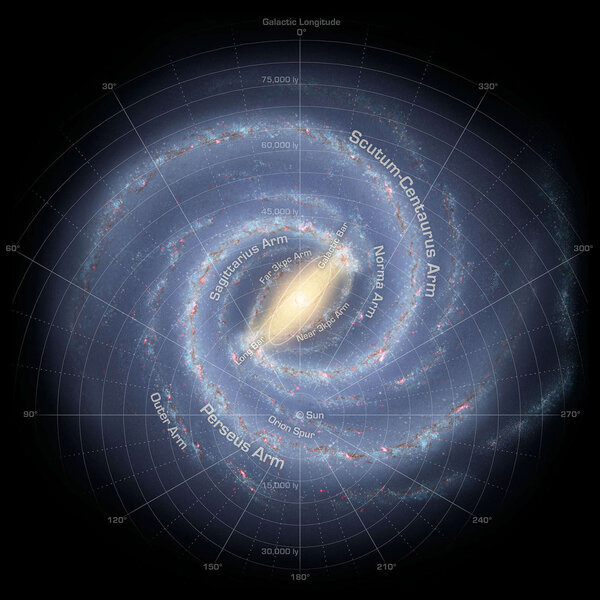Create a free profile to get unlimited access to exclusive videos, sweepstakes, and more!
How massive is the Milky Way?
How much stuff is in our galaxy?

We live in the Milky Way galaxy, a decently large spiral-armed stellar city that has a flat disk roughly 120,000 light years across, a giant halo that extends for a million light years, and a central bulge of stars shaped vaguely like a Tic Tac. Besides stars there's also gas, dust, and a lot of dark matter (which can't be seen directly, but contributes to the galaxy's gravity overall).
Besides the general structure and size, one of the most important characteristics of the Milky Way is its mass, a way to measure the total amount of stuff in it. It's a fundamental property of matter, so you'd think we'd have a decent handle on our galaxy's mass.
But it turns out we don't. It's actually really hard to measure. There are a lot of ways to do it, but they depend on very difficult observations and very complicated models of how everything in the galaxy behaves. Worse, there are other galaxies out there, like the Large Magellanic Cloud, which can skew the results. Until pretty recently, the best astronomers could do was estimate the mass to roughly a factor of two. And that's not good enough if we want to understand how, for example, the Milky Way interacts with other galaxies around it.
By coincidence, two research papers on the mass of the Milky Way were recently published on the same day by two different teams of astronomers using different methods. And holy moly, they both get pretty much the same answer, which is welcome.
One paper gets a total mass for our galaxy of 690 billion times the mass of the Sun (which serves as a convenient unit), and the other gets a range of roughly 536 – 784 billion.
Cool. But there are details and caveats, because of course there are. The Universe is complicated.
The first paper looks at stars in the Milky Way's halo, the roughly spherical cloud of stars (and dark matter) that surrounds the galaxy. Using a survey of halo stars that goes out as far as roughly 300,000 light years and combining it with measurements from the Gaia mission (which measures the distances and motions of stars), they look at the distribution and velocities of these stars through space. How fast they move depends on how much mass the galaxy has interior to them — so (to oversimplify a bit) if you look at a star 100,000 light years out, you can find the galactic mass out to that distance — so this can be used to get the mass out to various distances.
The statistical analysis is fiendishly complex, but what they wind up with is a model of the galaxy's mass versus distance from the center. Choosing a convenient distance out — 100,000 parsecs, equal to 326,000 light years — they get the value of 690 billion solar masses. If they go out to 200,000 (where they have to extrapolate somewhat so the uncertainties are a bit bigger) they get a mass of 1.08 trillion Suns. The uncertainties are roughly ±10%.
The second paper takes a somewhat different approach. They also use Gaia data and look to the Milky Way's halo, but instead of stars they use globular clusters, tightly packed collections of thousands to millions of stars. These orbit the galaxy center, and about 160 Milky Way globulars are known. How rapidly they move depends on their distance and the mass of the galaxy interior to them, like before. The astronomers also use the rotation curve of the galaxy obtained using Gaia data, which is a measure of how rapidly stars in the flat disk revolve around the galaxy's center versus distance; this also yields a mass.
They then apply some complicated models and statistics, though based on observations of the Milky Way that are pretty dependable. One thing they also took into account is how the Large Magellanic Cloud (or LMC), which orbits the Milky Way 170,000 light years out, might affect the structure of the galaxy; it can tug gravitationally and create substructures in the galactic disk, for example. There is some discussion that the LMC may be more massive than previously thought, so they try to take this into account as well.
Because their mass estimate is model-dependent, they get a range of masses for the Milky Way, which is why they get 536 – 784 billion Suns. The formal uncertainty (meaning how confident they can be due to the inputs they used) is about 15% on the lower part of the range but more like 40% on the higher end (it's also lower than a similar study done a few years ago, but still close within the quoted uncertainties). Still, it's pretty cool that the first paper's result is right in the middle of that range.
Both these estimates account for all matter, meaning both baryonic (what you can think of as normal matter: protons, atoms, molecules, and the like) and dark matter, about which we still don't understand much. Dark matter is probably about 85% of all matter in the galaxy, and normal matter 15%.
These estimates are an improvement on earlier ones, and astronomers will be able to use them to understand better the Milky Way's environment — we're in a small group of several dozen galaxies large and tiny — and even its future, since the Andromeda Galaxy is another beefy spiral only 2.5 million light years away, and may be headed toward us for a future collision. Armed with these numbers, hopefully we'll be able to better figure all this out.
Tip o' the warped disk to my colleague Ron Drimmel, who tweeted about this, and Galaxy Maps for the original heads-up.





























